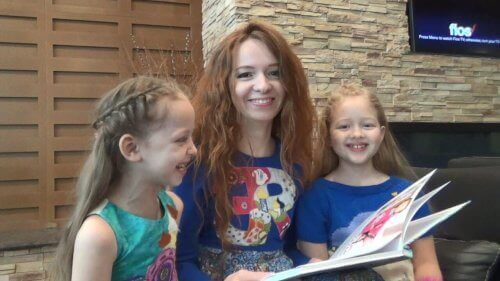5 Motivational Reading Activities for Your Kids


Written and verified by preschool graduate Marisol Rendón Manrique
Providing children with motivational reading activities early in life strengthens a habit that promotes intelligence and communication skills. Reading is a wonderful pastime that increases focus, activates mental processes, helps to expand vocabularies, and improves written and spoken expression.
In addition to the above, reading offers many benefits in one’s personal and academic life.
“Reading is a process of constructing meaning among the text, the context and the reader. Contrary to the perceptual motor model of reading, the meaning does not reside solely in the text, the context, or the reader, but by how these three factors interact. When combined, this is what determines comprehension.”
– Ministry of National Education (Colombia)
As the specialists at Oxford Learning say, reading should be a celebration, not a source of frustration. The key for children to see it this way is to introduce them to written language before they even learn to read. It’s also important to consider that each child learns and processes information differently.
Why are some children not motivated to read?
1. They see it as an obligation.
2. They have difficulties understanding what they read.
3. They think reading is boring.
4. They’ve yet to find a book that interests them.
How can you motivate kids to enjoy reading activities?
Once you’ve identified the best way to get your child interested in reading, keep the following reading activities in mind to provide further motivation.

1. Reading as a family
It doesn’t matter if it’s a cookbook, a storybook, a shopping list, or road signs on the highway. What really counts is that children learn to see reading as something necessary and important. The best way to motivate them is leading by example, dedicating family time to enjoy reading activities together.
2. Providing reading material
When children have different books and resources within their reach, they may become curious about exploring them. Be sure to choose books with eye-catching colors and illustrations early on.
Later, you can provide your children with stories and encyclopedias about the things that interest them and best suit their personalities.
3. Use technology appropriately
With the current technological tools, the way we teach children has changed dramatically. Although there is much talk of the negative implications of these changes, there are advantages to be had when it comes to reading. A tablet or e-book reader with interactive functions may provide motivation to read more.
One of the main benefits of these digital tools is that they can adapt to the needs and preferences of each child. You can select the number of lines you want to see on each page, as well as the size of the letters. This is perfect for children with special needs, who may have some difficulty with conventional books.

4. Show an interest in their reading
Your reaction when your children read can have a significant effect on them. It’s essential that you offer words of encouragement and feedback, as well as ask questions to see how well they’ve understood the material.
Allow them to choose books that interest them. This will make them think of reading activities as recreational rather than a chore.
Creative reading activities…
5. Plays
If you take your children to a play and then read the script as a family, they will understand that written works have a life of their own. You can also suggest making costumes and coming up with dialogue to reenact the story at home. You can do the same with song lyrics, poems, and comic books.
If you want to enhance your children’s cognitive, social and communicational development, make reading activities a daily practice. Over time, you’ll notice that your children will do better in school, show more discipline, and grow in terms of their written and verbal expression.
Providing children with motivational reading activities early in life strengthens a habit that promotes intelligence and communication skills. Reading is a wonderful pastime that increases focus, activates mental processes, helps to expand vocabularies, and improves written and spoken expression.
In addition to the above, reading offers many benefits in one’s personal and academic life.
“Reading is a process of constructing meaning among the text, the context and the reader. Contrary to the perceptual motor model of reading, the meaning does not reside solely in the text, the context, or the reader, but by how these three factors interact. When combined, this is what determines comprehension.”
– Ministry of National Education (Colombia)
As the specialists at Oxford Learning say, reading should be a celebration, not a source of frustration. The key for children to see it this way is to introduce them to written language before they even learn to read. It’s also important to consider that each child learns and processes information differently.
Why are some children not motivated to read?
1. They see it as an obligation.
2. They have difficulties understanding what they read.
3. They think reading is boring.
4. They’ve yet to find a book that interests them.
How can you motivate kids to enjoy reading activities?
Once you’ve identified the best way to get your child interested in reading, keep the following reading activities in mind to provide further motivation.

1. Reading as a family
It doesn’t matter if it’s a cookbook, a storybook, a shopping list, or road signs on the highway. What really counts is that children learn to see reading as something necessary and important. The best way to motivate them is leading by example, dedicating family time to enjoy reading activities together.
2. Providing reading material
When children have different books and resources within their reach, they may become curious about exploring them. Be sure to choose books with eye-catching colors and illustrations early on.
Later, you can provide your children with stories and encyclopedias about the things that interest them and best suit their personalities.
3. Use technology appropriately
With the current technological tools, the way we teach children has changed dramatically. Although there is much talk of the negative implications of these changes, there are advantages to be had when it comes to reading. A tablet or e-book reader with interactive functions may provide motivation to read more.
One of the main benefits of these digital tools is that they can adapt to the needs and preferences of each child. You can select the number of lines you want to see on each page, as well as the size of the letters. This is perfect for children with special needs, who may have some difficulty with conventional books.

4. Show an interest in their reading
Your reaction when your children read can have a significant effect on them. It’s essential that you offer words of encouragement and feedback, as well as ask questions to see how well they’ve understood the material.
Allow them to choose books that interest them. This will make them think of reading activities as recreational rather than a chore.
Creative reading activities…
5. Plays
If you take your children to a play and then read the script as a family, they will understand that written works have a life of their own. You can also suggest making costumes and coming up with dialogue to reenact the story at home. You can do the same with song lyrics, poems, and comic books.
If you want to enhance your children’s cognitive, social and communicational development, make reading activities a daily practice. Over time, you’ll notice that your children will do better in school, show more discipline, and grow in terms of their written and verbal expression.
All cited sources were thoroughly reviewed by our team to ensure their quality, reliability, currency, and validity. The bibliography of this article was considered reliable and of academic or scientific accuracy.
- de Cárdenas Cristiá, A., & Cabrera, L. R. (2008). Aspectos teóricos conceptuales dirigidos a la promoción de la lectura en niños y jóvenes. Ciencias de la Información, 39(2), 3-14. https://www.redalyc.org/pdf/1814/181421632001.pdf
- Cancino, E. C., & Sánchez, D. R. Incidencia de la lateralidad para abordar los procesos de lectura y escritura en niños de 5 a 7 años. http://repository.ucc.edu.co/bitstream/20.500.12494/6605/1/2019_Lateridad_Lectura_Escritura.pdf
- García, G., & Torrijos, E. (2008). Juegos para fomentar la lectura infantil. LD Books.
- González Álvarez, C. (2000). Estrategias y procedimientos para fomentar la lectura en la familia y en la escuela. https://ruc.udc.es/dspace/bitstream/handle/2183/8101/LYT_15_2000_art_7.p?sequence=1
- Jiménez, S. Y., & Rubio, E. L. (2010). El valor de la lectura en relación con el comportamiento lector. Un estudio sobre los hábitos lectores y el estilo de vida en niños. Ocnos: Revista de estudios sobre lectura, (6), 7-20. https://revista.uclm.es/index.php/ocnos/article/view/188
- Lomas, C. (2002). Cómo hacer hijos lectores. Ediciones palabra. España: Madrid.
- Macías, M. C. M. (2010). Los beneficios de la literatura infantil. Revista digital para profesionales de la enseñanza, 1-6. https://www.feandalucia.ccoo.es/andalucia/docu/p5sd7247.pdf
- Oxford Learning Centre. (2017). How to encourage good reading habits in kids. Oxford University Press. Recuperado de https://www.oxfordlearning.com/encourage-good-reading-habits/.
This text is provided for informational purposes only and does not replace consultation with a professional. If in doubt, consult your specialist.








